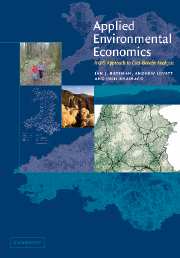Book contents
- Frontmatter
- Contents
- List of plates
- List of figures
- List of tables
- Foreword by David W. Pearce
- Preface
- Acknowledgements
- 1 Introduction
- 2 Recreation: valuation methods
- 3 Recreation: predicting values
- 4 Recreation: predicting visits
- 5 Timber valuation
- 6 Modelling and mapping timber yield and its value
- 7 Modelling and valuing carbon sequestration in trees, timber products and forest soils
- 8 Modelling opportunity cost: agricultural output values
- 9 Cost-benefit analysis using GIS
- 10 Conclusions and future directions
- References
- Index
- Plate Section
6 - Modelling and mapping timber yield and its value
Published online by Cambridge University Press: 22 September 2009
- Frontmatter
- Contents
- List of plates
- List of figures
- List of tables
- Foreword by David W. Pearce
- Preface
- Acknowledgements
- 1 Introduction
- 2 Recreation: valuation methods
- 3 Recreation: predicting values
- 4 Recreation: predicting visits
- 5 Timber valuation
- 6 Modelling and mapping timber yield and its value
- 7 Modelling and valuing carbon sequestration in trees, timber products and forest soils
- 8 Modelling opportunity cost: agricultural output values
- 9 Cost-benefit analysis using GIS
- 10 Conclusions and future directions
- References
- Index
- Plate Section
Summary
Introduction
In this chapter we present various models of timber production for the two species under consideration: Sitka spruce and beech. In the next section we present a brief review of previous studies. These have exclusively been based upon relatively small-scale surveys of tree growth; furthermore, they have also generally been confined to comparatively small areas and often to one topographic region, e.g. upland areas. Our study differs from these previous models in that it employs a GIS to utilise large-scale existing databases covering a very large and diverse study area: the whole of Wales. The subsequent section presents details regarding the various datasets used in this study and discusses how these data were transformed for the purposes of subsequent regression analysis. Subsequently, results from our models of Sitka spruce and beech growth rates are presented, while the following section presents and analyses GIS-created map images of predicted yield class. The final section applies the findings of the previous chapter to produce monetised equivalents of these results.
Literature review and methodological overview
Literature review
It is clear that tree growth rates depend upon a variety of species, environmental and silvicultural factors. Early work in this field relied on simple rules of thumb based upon relatively little supporting data (Busby, 1974) or analyses of single factors. Reviews across this literature provide a number of clues regarding the specification of a yield class model. An early focus of interest was the impact of elevation upon productivity (Malcolm, 1970; Mayhead, 1973; Blyth, 1974).
Information
- Type
- Chapter
- Information
- Applied Environmental EconomicsA GIS Approach to Cost-Benefit Analysis, pp. 158 - 183Publisher: Cambridge University PressPrint publication year: 2003
